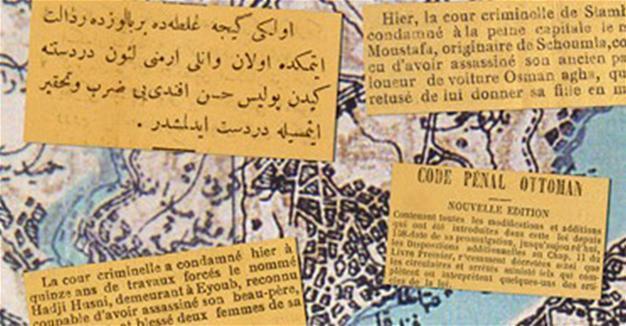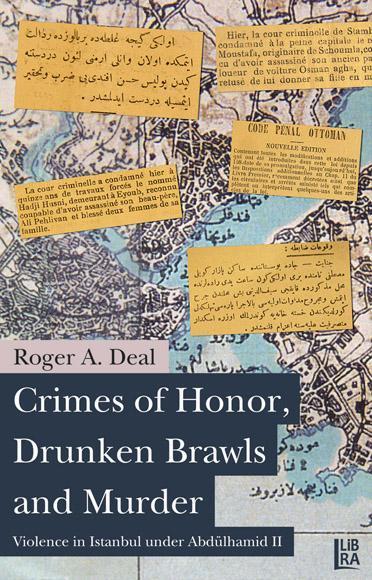Violence in Istanbul under Abdülhamit II
William Armstrong - william.armstrong@hdn.com.tr
 ‘Crimes of Honor, Drunken Brawls and Murder: Violence in Istanbul under Abdülhamid II’ by Roger A. Deal (Libra, 218 pages, 70TL)
‘Crimes of Honor, Drunken Brawls and Murder: Violence in Istanbul under Abdülhamid II’ by Roger A. Deal (Libra, 218 pages, 70TL)
Opinions about the era of Ottoman Sultan Abdülhamit II (1876-1909) are highly politicized in today’s Turkey. Abdülhamit emphasized pan-Islamist Sunni Muslim identity to try to bolster his dwindling empire, and he is today idolized by religious conservatives who see him as the last great symbol of Ottoman Islamic pride. A hugely popular TV drama currently broadcast on state-run TRT, “Payitaht” (The Last Emperor),
depicts Abdülhamit’s years in power through a spectacular, darkly conspiratorial worldview.
This revisionism has little regard for the facts. In one unintentionally funny episode of “Payitaht,”
Abdülhamit has British Queen Victoria poisoned and is the only person who knows the remedy. Through such serials, Turkish conservatives look back to historical events to explain contemporary politics and sooth themselves with an airbrushed version of the past. There has also been a surge in popular, historically dubious books on the era. Bending facts to fit a more flattering narrative, they generally tell us more about today’s fantasies than they do about the era itself.

I often wonder what serious historians make of all this. “Crimes of Honor, Drunken Brawls and Murder: Violence in Istanbul under Abdülhamid II” by University of South Carolina associate professor Roger Deal is a stimulating work of ground-level social history that avoids looking for seductive but misleading patterns in the era. It stands in contrast with much delusional narrative history, presenting findings about a highly politicized time without straining to draw sweeping conclusions.
Deal deliberately excludes politically-motivated violence from the study, even though it was a significant feature of the era. Armenian militant groups, international anarchist agitators, and clashes between Greeks and Bulgarians stemming from the political situation in the Balkans were all features of Istanbul in the late 19th century. Sultan Abdülhamit himself narrowly escaped an assassination attempt in a
bombing by the Armenian Revolutionary Federation in July 1905. The motivating factors of political violence were different from those of common criminal violence and thus “deserve a separate study,” Deal writes.
This book is instead based on painstaking examination of primary sources, detailing the range and texture of ordinary street violence in Istanbul at the time. Deal parses a wealth of examples from the archives, spanning the full spectrum of life in the cosmopolitan Ottoman capital. We get a colorful sense of street life, reading about a vivid cast of shady characters from all religious groups living in the Ottoman capital and lurking in gazinos, meyhanes, balozes, kıraathanes and kahvehanes.
It was actually a transitional period in how the Ottoman state maintained law and order. In previous centuries, the Janissary corps was largely responsible for enforcing the law in major urban centers. The Janissaries became increasingly corrupt and resented, prompting Sultan Mahmut II to ultimately do away with them in a bloody massacre in 1826 (dubbed at the time the “auspicious incident”). Effectively the first modern-style police force was established 20 years later in 1846, reflecting changes taking place in Europe.
By the Hamidian period, a modern police force was in place in most major cities. As the Ottoman Empire strove to modernize throughout the 19th century, it sought to assert control and guarantee the state’s monopoly on violence. But the period addressed by Deal was only a couple of generations after the destruction of the Janissaries and after the government had taken firm control.
Hangovers from an earlier age were still in evidence. Deal describes the “kabadayıs” and “külhanbeys” in this context. The former were effectively local strongmen responsible for maintaining neighborhood peace and stability, by force when necessary, wrapped up in complex codes of local honor. The latter were less reputable local toughs who often got mixed up in petty crime. Both kabadayıs and külhanbeys punctuate many of the cases outlined in the book.
“Crimes of Honor, Drunken Brawls and Murder” is an illuminating study of some lesser known aspects of late Ottoman Istanbul. Those who are genuinely interested in the complexity of the subject – rather than looking for an ideological crutch to lean on – will find it fascinating.
* Follow the Turkey Book Talk podcast via iTunes here, Stitcher here, Podbean here, or Facebook here.
 ‘Crimes of Honor, Drunken Brawls and Murder: Violence in Istanbul under Abdülhamid II’ by Roger A. Deal (Libra, 218 pages, 70TL)
‘Crimes of Honor, Drunken Brawls and Murder: Violence in Istanbul under Abdülhamid II’ by Roger A. Deal (Libra, 218 pages, 70TL) I often wonder what serious historians make of all this. “Crimes of Honor, Drunken Brawls and Murder: Violence in Istanbul under Abdülhamid II” by University of South Carolina associate professor Roger Deal is a stimulating work of ground-level social history that avoids looking for seductive but misleading patterns in the era. It stands in contrast with much delusional narrative history, presenting findings about a highly politicized time without straining to draw sweeping conclusions.
I often wonder what serious historians make of all this. “Crimes of Honor, Drunken Brawls and Murder: Violence in Istanbul under Abdülhamid II” by University of South Carolina associate professor Roger Deal is a stimulating work of ground-level social history that avoids looking for seductive but misleading patterns in the era. It stands in contrast with much delusional narrative history, presenting findings about a highly politicized time without straining to draw sweeping conclusions.